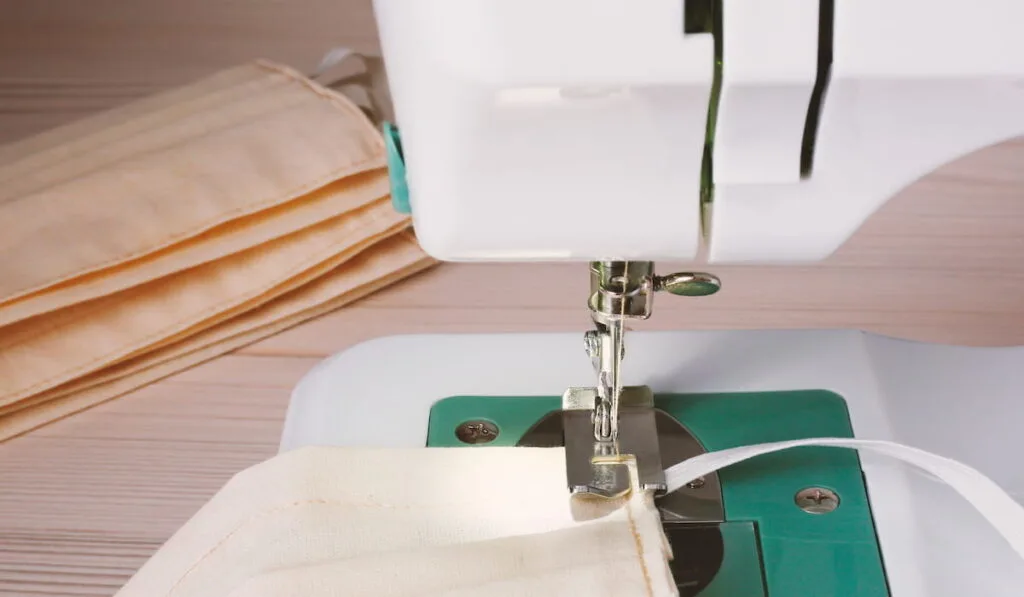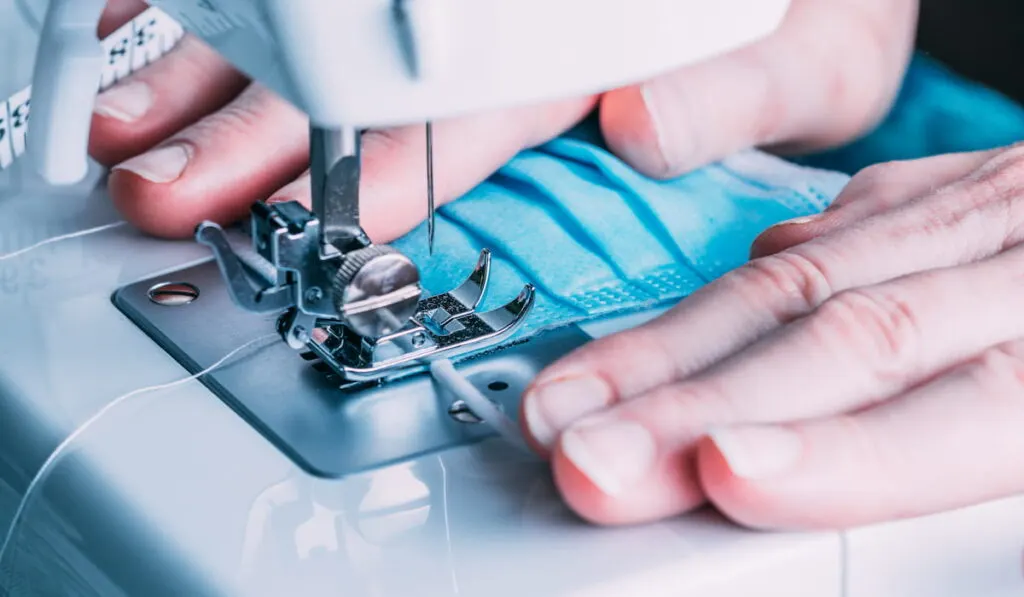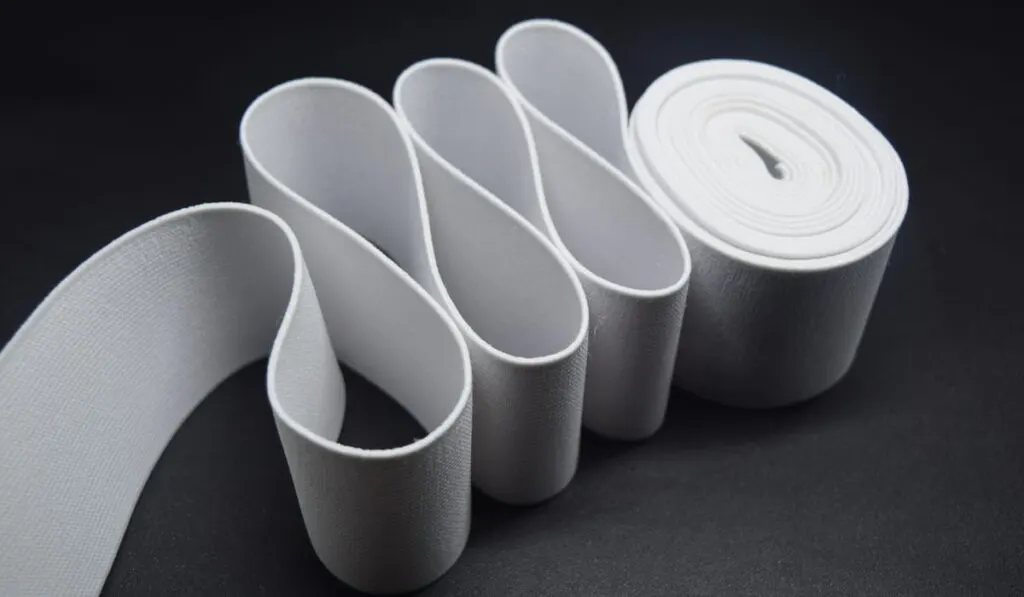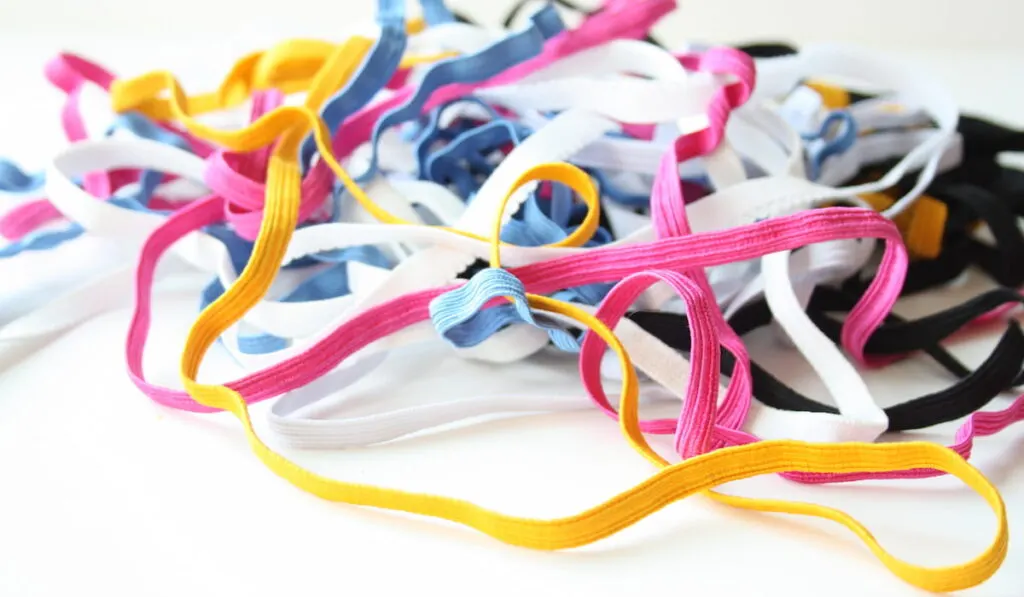Most times, when someone talks about sewing, people immediately think of fabric. But as you begin to get yourself involved in diverse sewing projects, you’ll find that you can sew other items that are not fabric.
This especially happens when combining materials to make more intricate projects. It’s important to understand whether you can safely sew with or through these extra items.
Can you sew through rubber bands?
You can safely sew through rubber bands, and they are commonly used in sewing projects that need a means of attachment that provides grip or close-fitting capabilities. However, this process differs from traditional sewing with just fabric. You need to consider the elasticity of the rubber band while sewing.

Rubber bands and other elastics have a number of practical uses in sewing. Let’s take a look at how you can effectively work with them on your sewing machine and in your various projects.
How to Sew Through Rubber Bands
Sewing through rubber bands is fairly straightforward. However, the process is bit different from working with standard fabrics since rubber bands have a very elastic quality.
While you can sew through rubber bands with regular sewing machines, you’ll get better results with an industrial-grade sewing machine.
If you have a regular sewing machine, you can still sew with rubber bands. But you will need to make sure you have the proper materials and supplies to do the job correctly and safely. These include:
- Heavy-duty sewing needles
- Silicone spray
- Heavy-duty thread
- Paper or tissue paper
- Teflon presser foot
Once you have the right supplies, follow these steps to sew through rubber bands on your machine:
- Insert the heavy-duty needles. The needles should preferably between size 16 and 18.
- Thread your machine with heavy-duty thread. This will offer better hold on the rubber bands compared to standard cotton thread.
- Install the Teflon presser foot. Rubber is smooth just like the standard presser foot on your sewing machine. If you use this, both materials will stick together. Changing to a Teflon presser foot will allow the materials to move through the machine properly.
- Spray a silicone-based lubricant. Keeping the needles and moving parts lubricated will ensure that the rubber slides easily between the needle and the thread.
- Check your machine manual. Depending on how thick the rubber, you may need to adjust the pressure foot tension.
- Proceed with sewing! Your machine is now ready to start working on your rubber band sewing project.
Can You Make Face Masks With Rubber Bands?
Rubber bands are versatile in sewing projects, and face mask are no exception. You can use a rubber band to make a face mask if you do not have the typical covered elastic for your project.
You can choose to sew the rubber band to the mask or work the fabric around the rubber band in a channel.

Sewing the rubber band to the mask fabric is quite easy. You can layer the fabric and rubber band together and move them through the sewing machine to achieve the desired look and placement.
If you do not want to sew directly through the rubber band, you will have to take a different approach by carefully wrapping the fabric to create a channel. Just follow these steps:
- Place the rubber bands on opposite edges of the mask fabric.
- Fold the fabric on each side to form a channel holding the rubber bands in place.
- Sew the fabric to close the channels and hold the rubber bands in.
Using Rubber Bands as an Elastic Replacement in a Pinch
Replacing worn-out elastic in skirts and pants is a fairly simple process. But what if you need to make a quick fix and do not have any elastic on hand? You might be surprised that you can easily replace the elastic in garments with rubber bands if you are in a pinch. Here’s how:
- Pull out the old elastic almost all of the way but not completely.
- Measure the length of rubber band you will need by placing it around the area.
- Adjust the rubber band length with no tension applied and add a 1-5 cm seam allowance. Then cut the rubber band to the correct length.
- Attach one end of the new rubber band to the old elastic that is still in the fabric channel.
- Pull the rubber band through the fabric using the old elastic until it is pulled all of the way through.
- Relax the tension on both the elastic and rubber band, and remove the old elastic.
- Sew the two edges of the rubber band together in place.
- Pull the garment fabric until the rubber bands disappear into it.
- Close the opening through which the old elastic was pulled.
Types of Elastics Used for Sewing
While rubber bands can be quite useful in your sewing projects, elastics come in different patterns and sizes. if you do a lot of sewing or work with garment (either new or repairs), you may want to have some elastics on hand.
Different elastics are a better fit for specific project types. Here, we’ll look at two main elastic categories and examples of each.

Garment Elastics
Garment elastics are workhorse elastics that come in various widths and two colors: black and white. They are not very decorative, so they may not be the best option if you want something flashy. They are very sturdy and long lasting.
Braided Elastic
Braided elastic is a garment elastic with parallel ribs running from one end to the other. It tends to get narrow when it is stretched, and once it is pierced with a needle, it stops stretching. As a result of this, the braided elastic is best used in making waistlines, sleeve hems, and necklines.
Knit Elastic
Knit elastic is a garment elastic with a very smooth appearance. Unlike the braided elastic, it does not become narrow when stretched and does not stop stretching when sewn. Knit elastic has a variety of uses but is best for working with light and medium weight fabrics.
Woven Elastic
Woven elastic, also called no roll elastic, has the reputation of being the toughest garment elastic. Woven elastic is characterize by its combination of vertical and horizontal ribs. The woven elastic does not narrow when stretched. It also retains its resilience when sewn. Woven elastic is best used when working on projects with heavyweight fabrics.
Specialty Elastic
Specialty elastics are fancier and more decorative elastics used when working with garments and other delicate projects. They are a derivative of garment elastics but typically have specific applications.
Clear Elastic
Clear elastic is transparent and very lightweight. Clear elastic can be very stretchy even though it narrows when stretched. It does not lose its resiliency when sewn and is best used when stabilizing light and medium weight knits.
Fold-Over Elastic
Fold-over elastic, or FOE, is a decorative elastic that comes in many different colors. This elastic has a ridge at its center, which allows it to be folded in half. It does not get narrow when stretched or lose its resiliency when sewn. It is best used when finishing undergarments and can also be used for finishing armholes, knit garments, and necklines.

Swim Elastic
Swim elastic is a variety of braided elastic that can withstand chlorinated water. The difference between a swim and braided elastic is the fiber content. Swim elastic becomes narrow when stretched and loses its resiliency when pierced and sewn.
Lingerie Elastic
Lingerie elastic is specifically designed for used in lingerie. This elastic does not become narrow when stretched, and it retains its resiliency when sewn. Lingerie elastic includes a push back that allows for comfort when worn.
Conclusion
You can sew through rubber bands as long as you have the right equipment on hand and are able to modify your sewing machine accordingly. When sewing rubber, ensure you change needles frequently since needles become dull when used on materials like rubber. Also, avoid sewing through very thick rubber which can be more difficult to work with. Rubber bands can be great if you are in a pinch, but consider keeping some common garment or specialty elastics on hand for future projects or emergencies.
